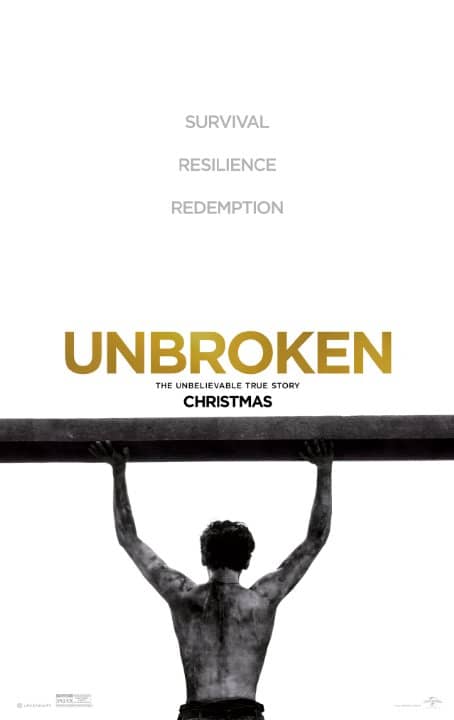Unbroken: Director Angelina Jolie misses the mark
Based on the impossibly true-life story of Louis Zamperini, Unbroken the book serves the justice it deserves. However, in comparison, the movie fell flat. Since this was only Angelina Jolie’s third directing job (and sixth time producing), she presented the movie with a forced effort that could be felt through the screen. Overall, Jolie was able to convey the story’s theme: the endurance of the human spirit. Unfortunately, in the end, she left more to be felt.
Straying from their norm of eccentric, wry, and ironic writing, the reputable brother-duo of Joel and Ethan Coen, known for their works such as Fargo, Barton Fink, The Big Lebowski, and O Brother, Where Art Thou? to name a few, contributed as one half of the writing team for Unbroken’s screenplay. Richard Lagravenese and William Nicholson made up the other half. The intensity and emotion that was displayed during the movie’s highest points could be accredited to Nicholson, who assisted in writing the screenplay for award-winning Les Miserables, a movie with enough drama and tear-soaked tissues to give Unbroken a run for its money.
The movie opens immediately with a scene in which Zamperini is flying as a bombardier with his crew against enemy Japanese bomber planes in World War II. The action is there full stop, but the suspense is lacking due to a lack of build-up and poorly-placed moments in the battle. From this, a taste of the pace that the movie will carry throughout most of its 137 minutes is given to the audience, which is then shoved further back in time with a flashback.
Unbroken covers the first 25 years of Olympic runner Louis Zamperini’s life, but for the most part, focused on the years in which Zamperini served in the U.S Air Force, stranded on a life raft for 47 days after a plane crash in the Pacific Ocean, and was a prisoner-of-war in a Japanese labor camp.
Flashbacks were inserted to serve as a thin basis for providing a background of his family life, Olympic running career, and other significant moments before his time in the Air Force. They are placed in parts of the movie where it would have been more proactive to build up suspense, *cough cough* the opening scene *cough cough*, rather than add a choppy, non sequitur, flashback.
Of course, like in all movie adaptations of books, there is the problem of time shortage, which the movies face, but the books do not. It is obvious that Jolie tried to fit in a small portion of Zamperini’s history within her time constraint, but the effort did not equate with the result. The content was (somewhat) there, but the timing could have been planned more efficiently and effectively.
The script’s dialogue was natural coming from the adequate supporting actors, even in the intense scenes involving Japanese labor camps. Especially in moments between Zamperini (Jack O’Connell) and his family, the dialogue had an uncanny organic quality to it.
O’Connell’s performance grew in power, making the role his own as the movie ran on and Zamperini was faced with increasing adversity. The antagonist Mutsushiro Watanabe, a Japanese work camp guard, was played by singer-songwriter and actor Takamasa Ishihara. Ishihara was able to perform this supporting role with a shocking amount of authenticity and anguish. Ishihara’s androgyny only added to the layers of Watanabe’s personality and added more depth than what was immediately shown in each scene in which he was featured.
The book Unbroken is written in chronological order of Louie’s life, while the movie begins during Louie’s time as a member of the Air Force and uses flashbacks throughout its first half for the viewer to gather knowledge of his background. The book has a better format because it allows the reader to become more acquainted with Zamperini’s background and his devil-may-care personality before seeing him transform into the roles of a pressure-filled bombardier and shattered prisoner-of-war. The latter versions of Zamperini are the ones that the movie focuses on, and it makes the movie difficult to watch at times.
Related to timing, the scenes that were most prolonged were the ones in which Zamperini suffered beatings from Watanabe and other Japanese guards. While an important part of Zamperini’s story is his survival of the labor camp, there was an excess in these overly brutal exhibitions, which made fellow moviegoers cringe in the theatre seats. Only two or three out of the several graphic interactions between Zamperini and Watanabe added to the viewer’s empathy of Zamperini and the increase of suspense within the plot. Time from the superfluous beatings could have been efficiently exchanged for personal Zamperini moments in order to increase attachment to the main character, effectively making the remaining scenes involving beatings twice as powerful.
If you are looking to break in a new inhaler or want to get the type of adrenaline rush equivalent to one of being chased by alligators, bring a magazine, flip through it for the first half of Unbroken, then settle in for an emotional rollercoaster.










